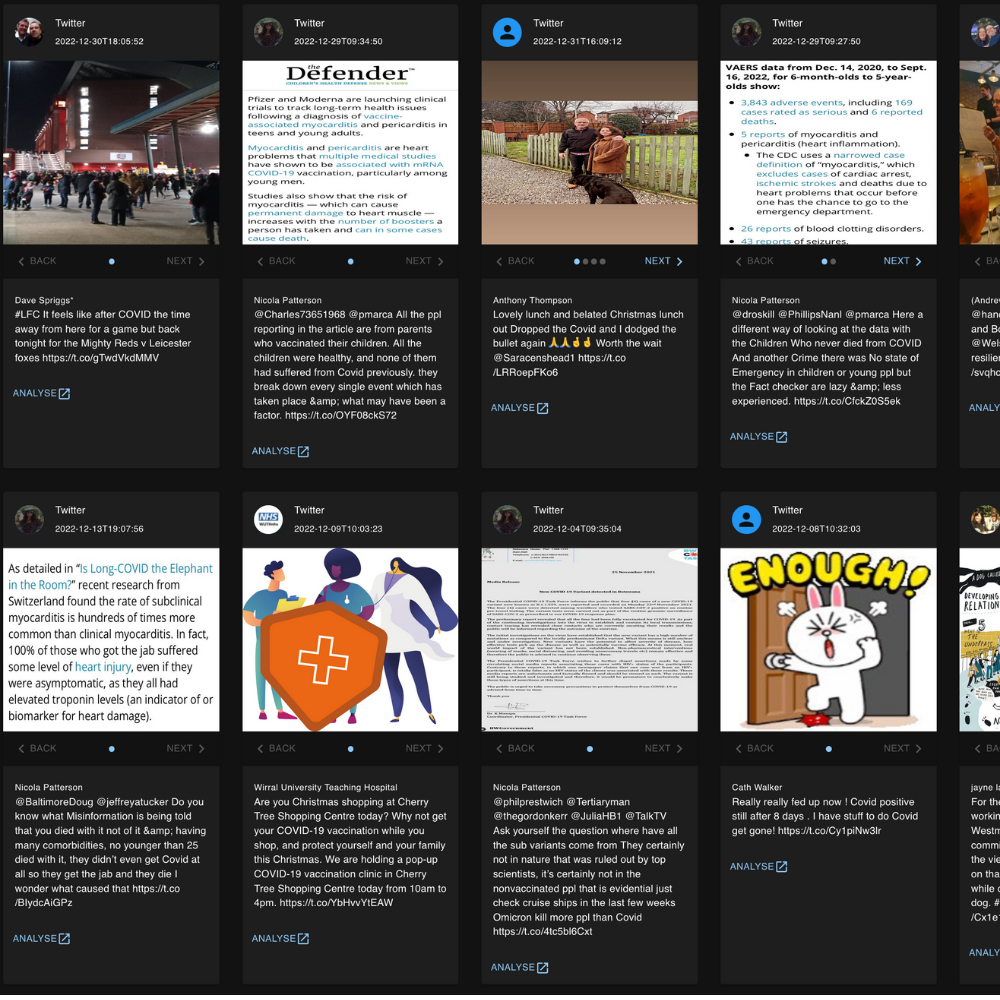The University of Liverpool’s Digital Media & Society Institute (DMSI) and the VEC’s Data Science team are working collaboratively to demonstrate how communications across media platforms can support developing a greater understanding of the public’s opinions and shifts in perceptions regarding COVID-19. Specifically, the project team are considering how language, images, and video communicates key ideas in government messages, online news and social media and the stance towards those messages.
The project team compiled data from various social media platforms, including X (Twitter), YouTube, and Reddit, alongside official Government updates from gov.uk, and more than 100 national and local news sources such as The Independent, The Guardian, and The Liverpool Echo. Social media platforms are often where users freely express their opinions, making them less reserved and guarded, in some cases using geotag technology to allow for location identification.
Additionally, the project team used timelines of key events and NHS Covid-19 hospital cases and bed occupancy to understand patterns and trends.
THE SOLUTION
The project team stored this data within a digital infrastructure to permit in-depth analysis, using a dashboard to showcase a wide range of collated data from multiple sources across allocated periods from the Liverpool City Region (LCR).
The AI capabilities are used to discover a range of linguistic features using Natural Language processing. For example, topic modelling tools quickly pull together trending topics across several platforms, as sentiment analysis determines the emotions associated with different messages. The AI-focused capabilities included computer vision for object detection, facial recognition, celebrity recognition, and optical character recognition (reading text from images). This enables the accurate search and identification of images and videos relating to key search words or even of individuals and policy decision-makers, which may have links assigned to this from a social media post.
The project team can identify illicit or even hateful content as well as multimodal and latent SVO (subject–verb–object) analysis for simultaneously finding meanings from images and text. The results are interpreted in relation to the timeline of key events during the pandemic, for example, lockdown, availability of vaccinations, hospitalisation rates etc., assisting with the identification of misinformation.
BENEFITS
This multimodal analysis platform enables the visual representation of multiple variables and data sets simultaneously, allowing for the swift identification of correlations with official messaging, online news and the public opinions shared on social media and the spread of misinformation. Government officials and decision-makers can pinpoint popular keywords and topics, clarifying any misconceptions or misunderstandings regarding policy changes.
The findings highlight evolving opinions and perceptions regarding rapidly changing government regulations and health guidelines whilst also revealing the influence of local and national media on public perception. Promptly addressing public concerns can be achieved through tailored messaging, assisting in dispelling misconceptions and clarifying information, which is essential for future campaign success.
In the future, real-time data collection will facilitate immediate research and prompt decision-making, ensuring responsive and effective communication during crisis management efforts.
We are using digital itself – such as digital media, data analytics and AI – to help us research and understand our digital society. This is only possible through interdisciplinary collaboration between DMSI and VEC.
– Professor Kay O’Halloran, Department of Communication and Media and Co-Director of the Digital Media & Society Institute (DMSI), University of Liverpool
Next Steps
The project team is exploring additional social media channels such as TikTok, which famously uses video and mp4 files for communicating. Data from additional resources and platforms will enhance understanding of public reactions and enable the team develop more sophisticated methods for analysing video footage.The project team will also further investigate cases where text and imagery that do not necessarily align.
This type of contradictory use of media can often be seen in memes which recontextualise and subvert mainstream messages in official media channels.In collaboration with the BBC, the project team have expanded the area of interest to the Eurovision Song Contest, hosted in Liverpool in May 2023. This project will investigate how this event was reported by the national media and local press whilst comparing it against social media posts before, during and after the events. The project aims to investigate how the event was received by assessing the visitor experience from those who live locally in addition to those who travelled from all over the world to attend the popular event.
Understanding how health-care messaging is received and translated by the public is vital, especially during a public health emergency.
This project provides fascinating insights into how community perceptions of the risk from COVID-19, expressed via social media, changed as events unfolded in 2020 and 2021. The findings have implications for the handling of future health crises, notably the need to (re-)build trust in officialdom before the next pandemic is upon us.
– Dr Ray Kent, Chief Operating Officer, The Pandemic Institute
